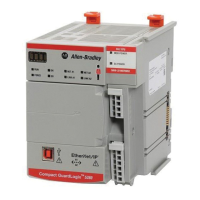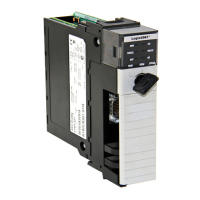Behavior models used in CIP Motion
Rockwell Automation Publication MOTION-RM003I-EN-P - February 2018 33
When the update period of the Motion Planner is short enough relative to the
dynamics of the command trajectory, or is comparable to the device control
calculation period, fine interpolation may not be necessary. The Motion Planner
can make this determination by comparing the planner update period to that of
the device control calculation period. When fine interpolation is used, the planner
adds additional planner update periods to the planner time stamp, so it is
advantageous to eliminate this planner update period delay if interpolation is not
necessary.
Even though fine interpolation may not be necessary in some cases, it does not
mean that the command data is to be applied directly to the device's control
structure. It still may be necessary to calculate the above polynomials so the device
can extrapolate the command value when the device's control update occurs. That
is because, in general, the device's control update time stamp does not need to
match the time stamp of the command data.
Finally, there are applications and CIP Motion device types that do not require
the dynamic accuracy that time-stamped interpolation and extrapolation provide.
Various velocity and Torque Control applications, for example, may fall in this
category. In general, command data can also be applied to the control structures of
Variable Frequency drives without interpolation or extrapolation.
See also
Command Generation Behavior on page 28
When operating in Closed Loop Velocity mode, the Ramp Generator feature of
the Velocity Fine Command Generator block is applied to the Controller
Velocity Command value sent by the controller when the Command Target
Update element of the connection is set to 'Immediate' mode. In Immediate
mode, the Command Data is applied immediately to the device's control
structure. Because there is generally no Motion Planner generating the Command
Data in this mode, the Command Data value from the controller can change
drastically from one update to the next. To address this condition, a Ramp
Generator function is needed to ramp the motor to the new Command Data value
within the dynamic limitations of the system. As an example of if the Controller
Velocity Command value suddenly changed from 0…30 revolutions per second in
Immediate Mode, the Ramp Generator would produce a Fine Velocity Command
signal that accelerates the motor to the Controller Velocity Command value based
on the configured Ramp Acceleration and Jerk Control attribute values. The
Ramp Jerk Control attribute determines what percentage of the acceleration or
deceleration ramp is S-Curve with the remaining portion of the ramp governed by
the fixed Ramp Acceleration or Deceleration attribute values. If the Command
Target Update element of the connection is not set to 'Immediate', the Ramp
Generator has no impact on the Fine Velocity Command signal.

